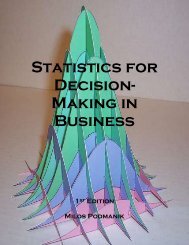Tutor Training Manual.indd - Chandler-Gilbert Community College
Tutor Training Manual.indd - Chandler-Gilbert Community College
Tutor Training Manual.indd - Chandler-Gilbert Community College
Create successful ePaper yourself
Turn your PDF publications into a flip-book with our unique Google optimized e-Paper software.
14<br />
Active Listening Strategies<br />
How to Listen so That you Really Hear<br />
Good listening skills are one of the most vital qualities of a tutor. The better you listen, the<br />
more you will understand. The more you show understanding, the more your tutee will<br />
talk. For a tutoring session to be successful, a non-judgmental atmosphere is critical, as is<br />
your ability to understand the other person’s point of view.<br />
Active Listening intentionally focuses on the speaker in order to understand what he or<br />
she is really saying. Active listening is more than just hearing; it’s hearing with the focus<br />
placed on what the speaker is saying and reserving your reply until comprehension is<br />
complete. An active listener never interrupts the speaker and always listens to understand.<br />
Once the speaker has finished, an active listener is able to paraphrase the speaker’s remarks<br />
including both verbal and nonverbal cues.<br />
Good summary phrases include:<br />
“What you’re saying is…”<br />
“It seems to me what your saying is…”<br />
“You sound…”<br />
“It sounds to me like…”<br />
Empathy is imagining oneself in another person’s situation and experiencing that<br />
situation from their point of view. You try to become the other person so you can<br />
understand the reasons behind their feelings.<br />
You communicate empathy with feedback: After listening to the other person, you “feed<br />
back” a summary of what you heard, focusing on both the person’s emotions and the<br />
reason(s) for them (“You feel this way because . . .”). For example,<br />
Student:<br />
<strong>Tutor</strong>:<br />
“I can’t believe I bombed that Chem exam. I studied and studied; I can’t<br />
figure out why I can’t get it. I don’t want to blame the professor, but the<br />
average was only 47; no one I talked to did OK either. I need to do well in<br />
this class. I’m getting desperate.”<br />
Your distress is understandable. It’s really frustrating to work so hard and<br />
not have things turn out and not know why.<br />
The tutor’s response focused on the student’s emotions by using the words “distress” and<br />
“frustrated.”<br />
The <strong>Tutor</strong> did not:<br />
judge - “You should have studied harder”<br />
negate - “Don’t feel that way. It’s only one test.”<br />
sympathize - “Sometimes professors can be such jerks”<br />
rescue - “It’s too bad. I’m sure you’ll do better next time.”<br />
own - “It’s my fault for not focusing on those problem sets.”<br />
In summary, the process of actively listening and communicating empathy allows the tutee<br />
to control the direction, pace and conclusion of the tutoring session. The tutee does most of<br />
the work which better equips him or her to answer similar questions in the future.<br />
Arkin, M. and Shollar, B. The <strong>Tutor</strong> Book, New York, Longman Inc., 1982.<br />
Adapted from: http://www.ccsf.edu/Services/LAC/lern10/listening.html

















